Tossed Medicine, Delayed Housing: How Homeless Sweeps Are Thwarting Medicaid’s Goals
SAN FRANCISCO — Andrew Douglass shoved his clothes and belongings into plastic trash bags as five police officers surrounded his encampment — a drab gray tent overflowing along a bustling sidewalk in the gritty Tenderloin neighborhood, where homeless people lie sprawled on public sidewalks, sometimes in drug overdoses.
Officers gave him a choice: Go to a shelter or get arrested and cited for sleeping outside.
Douglass was trying to figure out what to do as he dismantled his tent. If he accepted temporary shelter, he’d risk missing an important appointment with his street medicine case manager, who was due to meet him at his tent in the morning to help him secure a low-income housing unit with wraparound services — and he worried about losing his medications, ID, and other vital documents again in another homeless sweep.
Douglass, who didn’t have a working cellphone, knew if he moved from where he’d slept for months, his case manager might not be able to find him. “I’m so close to getting housing. I need to be here tomorrow morning so I can try and get inside,” he said, trying to reason with officers as he was handcuffed and arrested for illegal lodging.
California, the epicenter of the U.S. homelessness crisis, is cracking down on people living outside like never before, taking an aggressive new stance to dismantling and clearing homeless encampments in the wake of a watershed U.S. Supreme Court ruling in late June that makes it easier for government agencies to fine and arrest people for living on streets and sidewalks, in broken-down vehicles, or within public parks — even if there is no shelter or housing available. From San Francisco to Los Angeles, communities are launching cleanup operations, ratcheting up enforcement of existing anticamping laws, and, in some places, passing new laws to try to prevent people from living outdoors.
On the ground, health care experts and homeless service providers say the law enforcement crackdown is undercutting taxpayer investments in evidence-based treatment and housing services that are being deployed by cities and states around the nation as politicians look to the health care system to aggressively move people off the streets.
The sweeps — which have taken off under Democratic Gov. Gavin Newsom, who issued an executive order in late July requiring state agencies to remove encampments and encouraging local governments to do the same — have unleashed chaos for homeless people and are breaking crucial connections with health care providers, social service agencies, and housing navigators trying to help them get healthy and off the streets.
Newsom’s hard-line stance is undermining his signature Medicaid initiative, known as CalAIM, which dedicates $12 billion over five years in part to helping homeless people receive health care, housing, and social services. The experimental program, meant to stabilize the most vulnerable and keep low-income patients out of costly institutional care in hospitals, jails, and nursing homes, for instance, launched in early 2022 with backing from the Biden administration, and provides state and national health care funding to street medicine teams, hospitals, health insurance companies, community clinics, and other organizations to serve homeless people.
It comes as Newsom announced this month that his health secretary, Mark Ghaly, who has spearheaded the state’s infusion of social services for homeless people into the health care system, would be stepping down.
Encampment clearings are also upheaving long-standing federal health policies that provide billions of dollars each year to street medicine providers, case management teams, and front-line community clinic workers, including through the national “Health Care for the Homeless” program, which is also aimed at helping homeless people get healthy and navigate a path to permanent housing.
Newsom has been emphatic that streets are not a home and that it’s unsafe to let people live outside amid public health hazards like rats, drug needles, and piles of trash. The second-term governor, who has threatened to withhold homelessness funding from communities that fail to show enough progress, argues that his policies are helping get people long-term housing and services.
“There are simply no more excuses,” Newsom said in July.
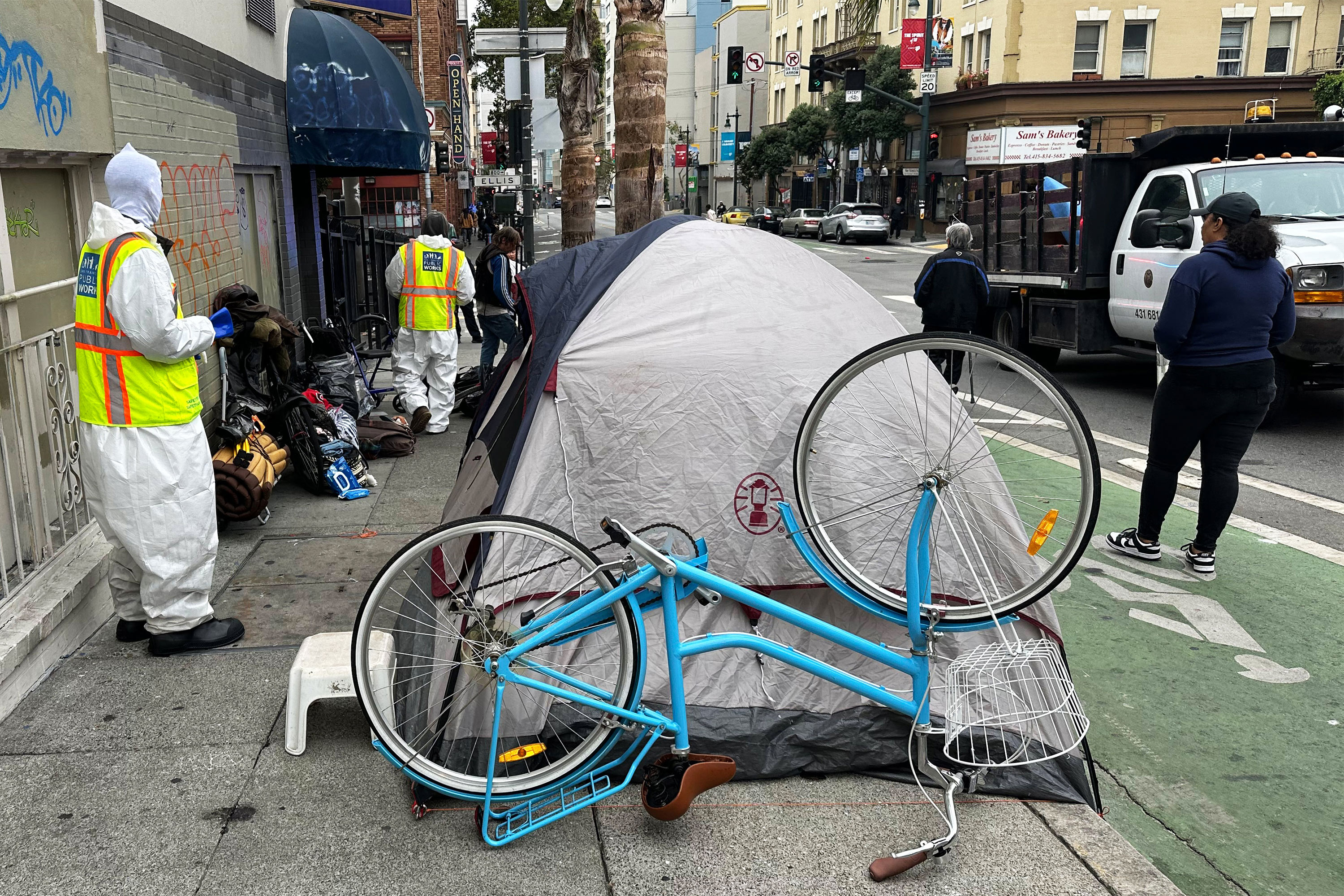
Health care providers and homelessness experts say the result is a slow-moving health care catastrophe instigated by the very Democratic politicians touting the need for care and services around California, home to more homeless people than any other state in the nation.
No place is going as hard as San Francisco, a fiercely liberal city that has long embraced its reputation as a place where homeless people could find refuge and robust services.
Now, case managers, housing navigators, and street medicine teams say vulnerable people are growing sicker amid the crackdown and that many of their patients have simply disappeared. Others have lost medications and critical documents like birth certificates and Social Security cards, setting back efforts to stabilize people with housing, mental health services, and addiction treatment. Front-line providers here say the city has become a glaring example of homelessness policy gone wrong.
“All the sweeps and arrests are doing is moving people to the next sidewalk and disrupting their continuity of care. It’s a huge waste of resources,” said Shannon Heuklom, a primary care provider and an expert in street medicine for the San Francisco Community Health Center, with a clinic nestled in the heart of the Tenderloin.
“Some portion of folks may end up in a shelter, but for the most part the city is just moving them all around and making them more unwell, making their mental health worse, making their physical health worse,” she said.
Disrupted Care
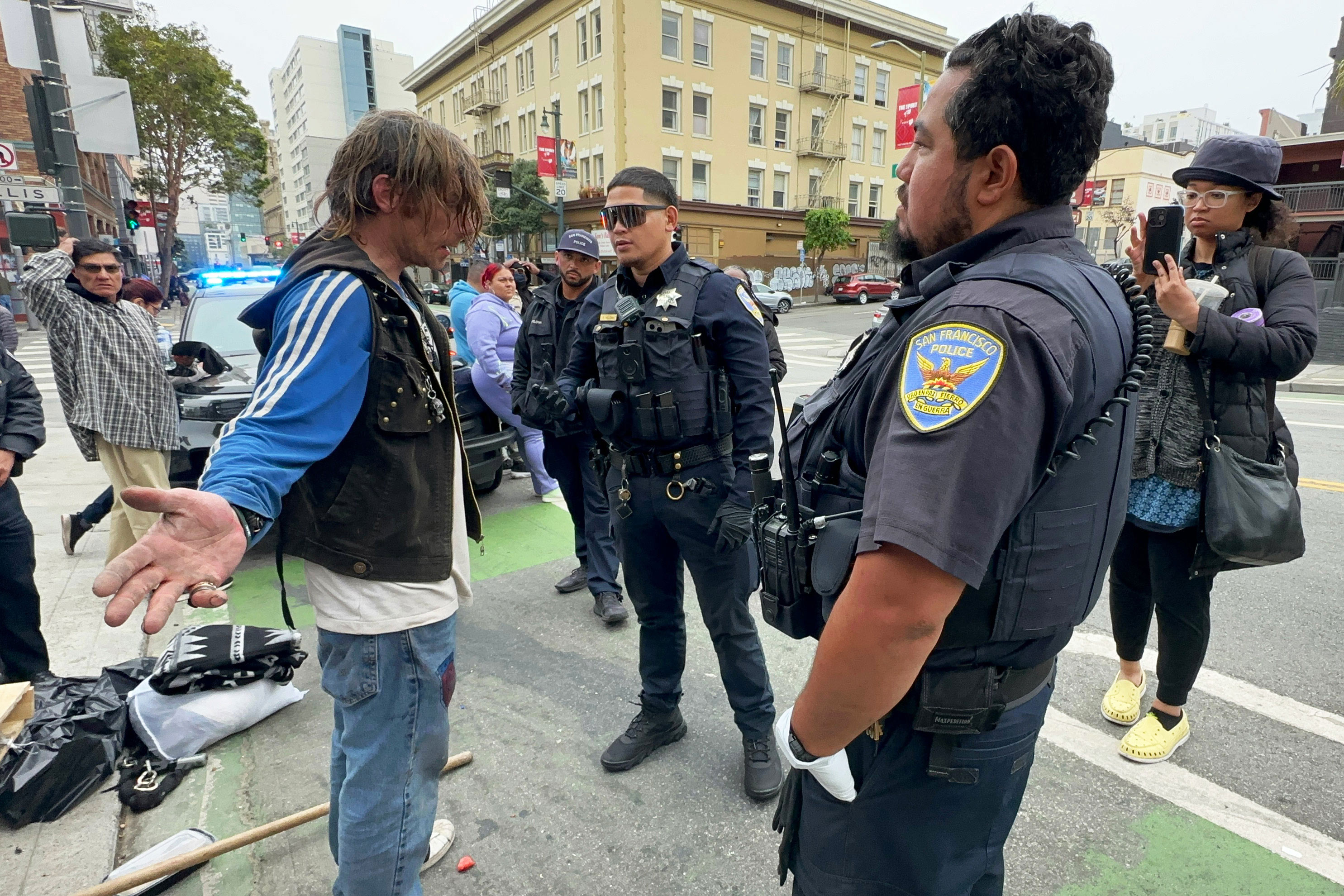
In the Tenderloin, Douglass was frantic. Police told him and his wife, Jasmine Byron, and another partner, Christina Richardson, that they could avoid arrest if they went into a massive congregate shelter. But they’d have to sacrifice most of their stuff, taking just two bags each. They’d already lost lifesaving medications, including for epilepsy, in a previous camp clearing. And Douglass had finally replaced his ID and asthma medication; he didn’t want more stuff thrown away amid the chaos.
On this early August morning, Douglass opted to stay with his belongings. The trio are part of about 70 homeless arrests in San Francisco since the city’s mayor, London Breed, ratcheted up cleanup operations in the beginning of August following the Supreme Court’s decision in late June, according to San Francisco Police Department spokesperson Evan Sernoffsky.
“We’re here to enforce the law,” said Lt. Wayman Young, one of the five officers. “We get a lot of complaints: People can’t use the sidewalk; there’s a lot of garbage.”
As the three were separated and cuffed, a woman driving by stuck her hands out her window and clapped, cheering the sidewalk arrest and yelled “Thank you!” A passerby in a wheelchair averted the tense standoff by rolling into a traffic lane, dodging vehicles as he looked for a vacant section of sidewalk to use.
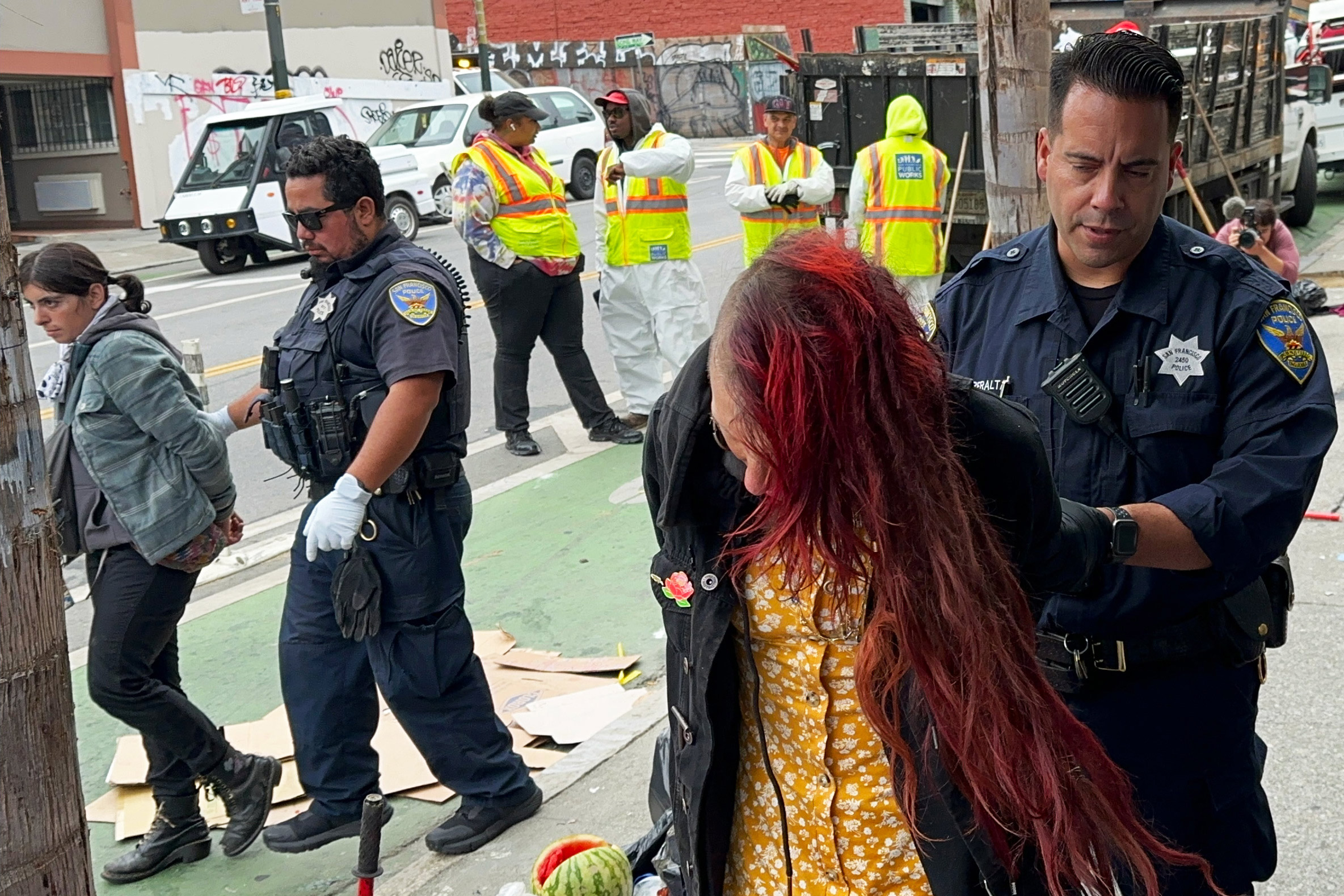
Douglass missed his housing appointment the morning after his arrest, confirmed his street medicine case manager, Justin Jackson from the San Francisco Community Health Center. Amid his tossed belongings were his ID card, which is required to get into housing, so he was back in line at the clinic the next day filling out a Department of Motor Vehicles voucher form to replace it for free.
Because Douglass is homeless and on Medi-Cal, California’s version of Medicaid, he is eligible for CalAIM services that assist homeless patients with finding a permanent place to live, as well as helping to cover security deposits and utility bills. CalAIM also offers eviction prevention support, and next year California is expected to add a new Medi-Cal benefit providing up to six months of free rent or temporary housing.
But with his documents thrown away, his eligibility for housing was delayed.
Front-line workers are now spending immense time and resources helping people replace valuables like medications, Social Security cards, and birth certificates lost due to sweeps. They notice patients are skipping routine health care and spot an uptick in drug use, anxiety, and depression.
“This is just making homelessness worse,” said Evelyn Peña, a CalAIM care manager at the Mission Neighborhood Health Center in San Francisco.
Taylor Cuffaro, a nurse practitioner and street medicine provider with the San Francisco Community Health Center, trudged the streets of the Tenderloin with Eli Benway, a licensed clinical social worker who provides talk therapy and other behavioral health treatment on the street, searching for patients on a bright August afternoon.
Some needed help managing chronic diseases and mental health conditions. Others were due for antipsychotic injectables that last longer than pill medications. Some needed refills of HIV medications.
“Health insurance companies aren’t just going to give you more medication,” Cuffaro said. “That’s not how it works, so people really are at risk of dying faster.”
Part of what’s being squandered is trust, which is vital for getting people off the streets. “These sweeps are just making our job impossible,” Cuffaro said, searching unsuccessfully for a patient in an alley.
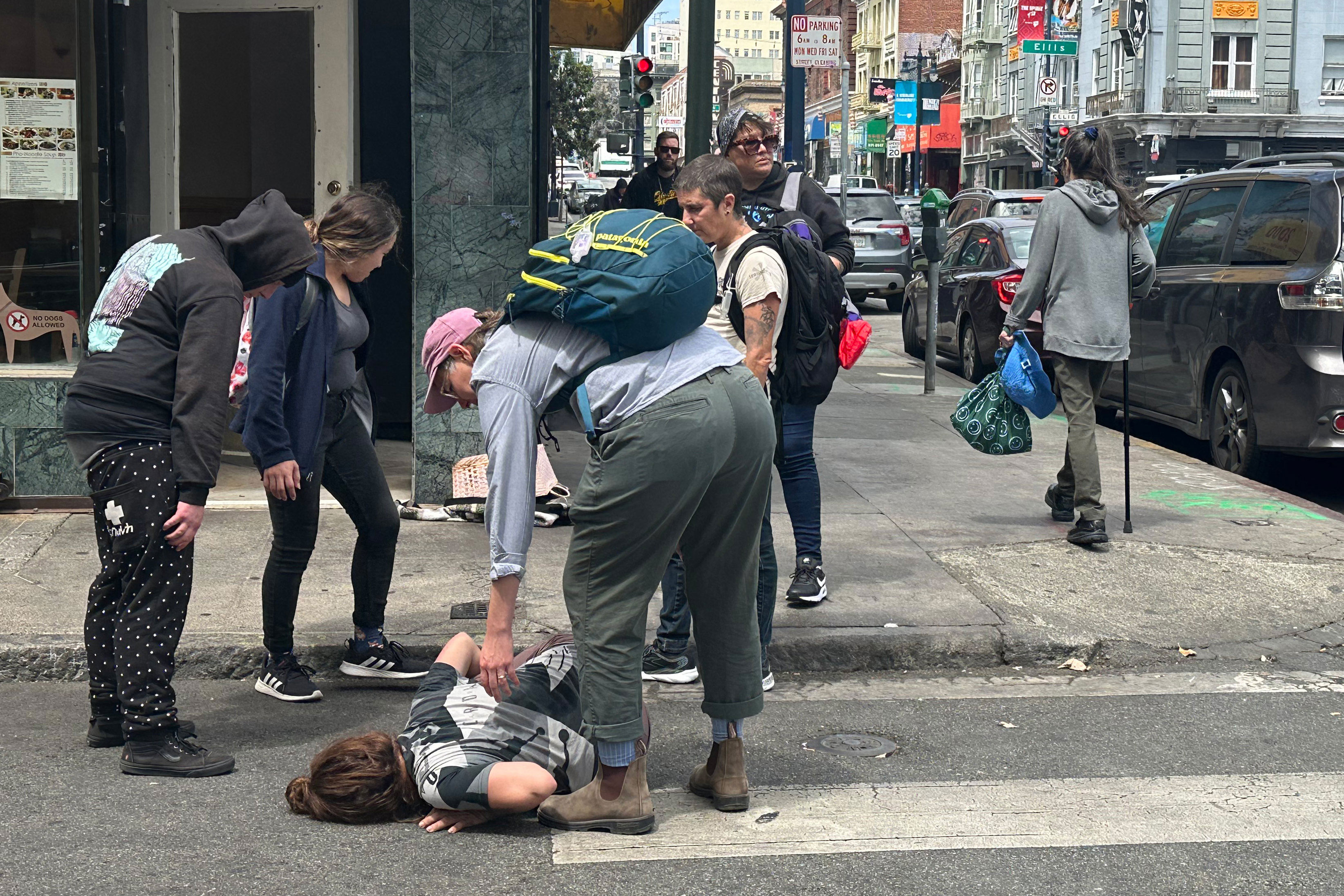
Politics of Homelessness
The statewide crackdown is playing out despite a growing body of evidence showing that providing robust health care, along with social services and intensive case management, can effectively move homeless people off the streets and improve health, while also saving taxpayer and health care spending on costly institutional care.
Democrats are embracing a get-tough approach as public patience wears thin over the intractable crisis. Newsom’s stance is not entirely new: During his tenure as San Francisco mayor, from 2004 to 2011, he spearheaded controversial homelessness ideas, including an ordinance known as sit/lie, which made it illegal to sit or lie on public sidewalks.
Newsom and local leaders, including Breed, say they must balance ensuring public safety and clean streets with a humane approach to clearing camps, while trying to get people indoors. Breed administration officials argue that while some homeless people do accept shelter, many are opting to stay on the streets while declining treatment.
“People won’t accept shelter, and they won’t follow up on their medical care or behavioral health treatment or any of that, often because they need to stay and monitor their belongings, some of which are totally soiled and becoming a health hazard,” said David Nakanishi, a clinical social worker who heads the Breed administration’s Healthy Streets Operation Center, which spearheads the sweeps.
In Los Angeles, meanwhile, street medicine provider Brett Feldman is losing his patients amid the sweeps. “It really undermines our housing efforts,” he said.
A city report released in May found that clearing camps and enforcing anticamping laws that ban people from sleeping, sitting, or keeping belongings on sidewalks in certain sensitive areas, including school zones, parks, or freeway underpasses, is not effectively helping people into housing. After spending roughly $3 million enforcing anticamping laws from 2021 to 2023, the report found, the city placed just two people into permanent housing and 81% of encampment sites have been repopulated.
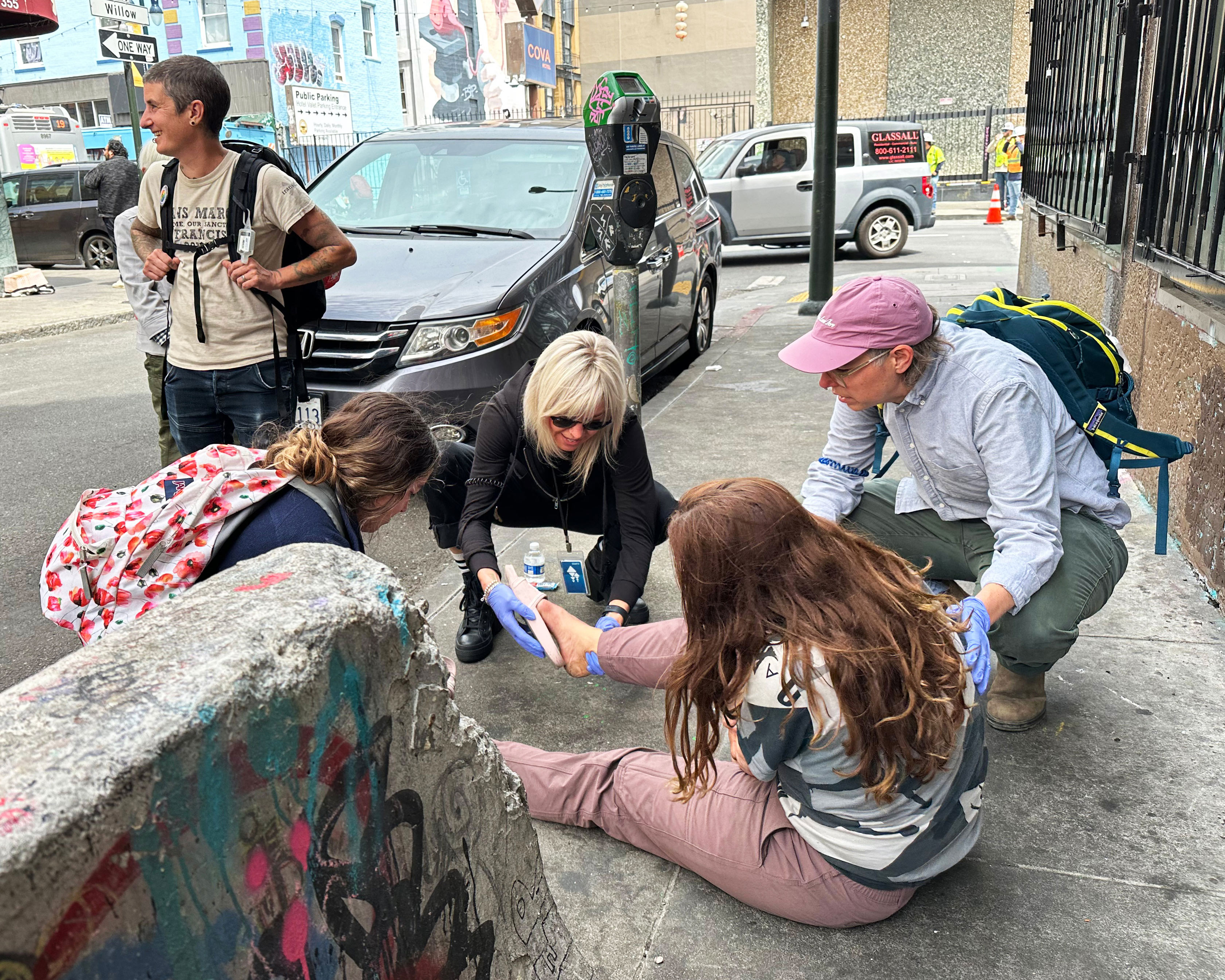
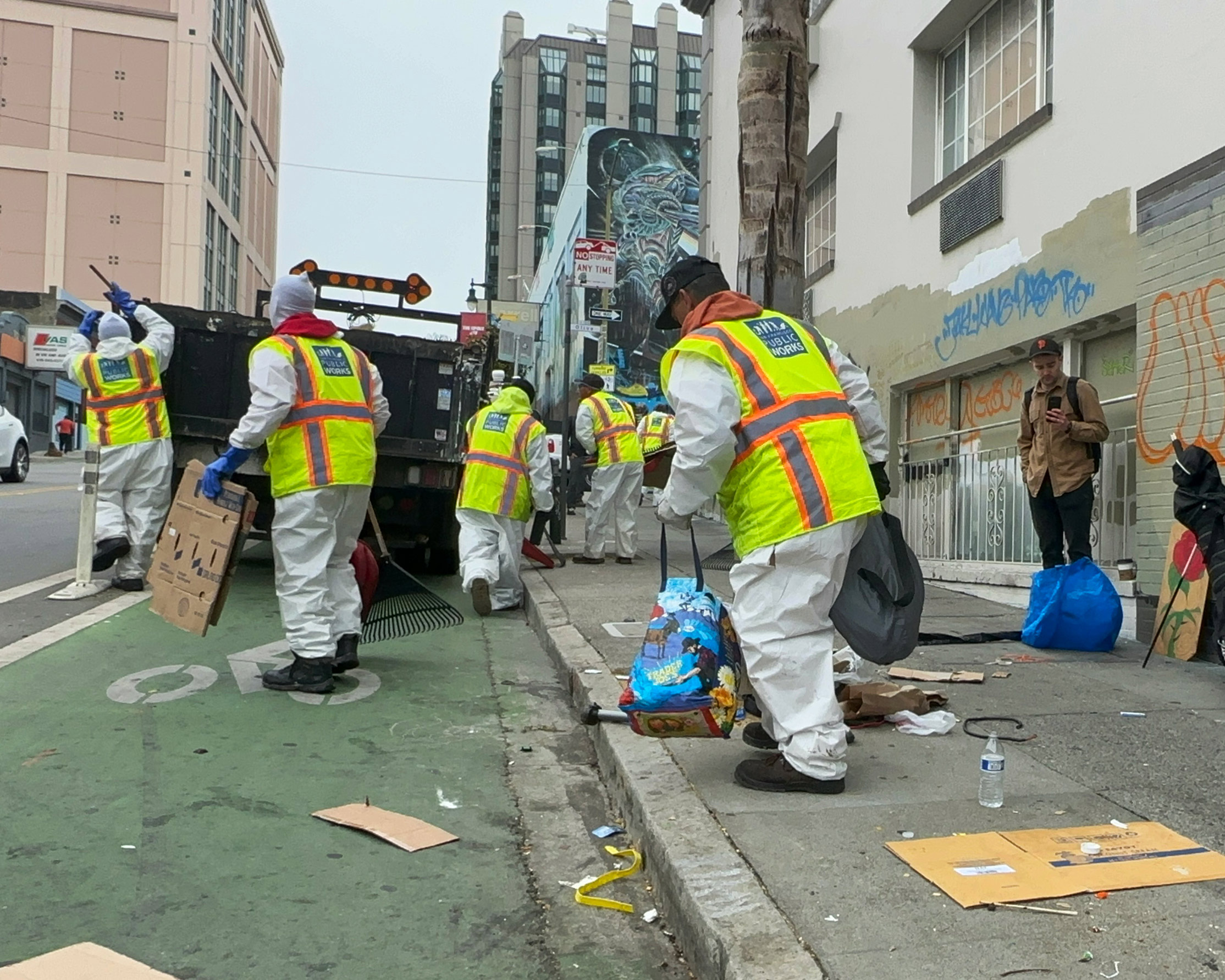
In one central Los Angeles district where law enforcement is not aggressively enforcing anticamping laws, street homelessness fell roughly 38% in a one-year period from 2023 to 2024, said Indu Subaiya, interim CEO for the nonprofit Healthcare in Action, which has been housing and treating patients there.
“We’re starting to actually see results and reductions in unsheltered homelessness,” Subaiya said. “However, in Southern California counties aggressively enforcing Newsom’s executive order and clearing encampments, we’re seeing our patients and their medical conditions set back profoundly.”
Once Douglass was released, he was back in the Tenderloin hunting for housing and popping his tent up the street from his previous hangout.
“Every time I try to get my documents to get housing, I get knocked backwards,” he said. “I guess the city thinks we all need to be in handcuffs.”
By the next morning, the encampment had grown twice in size.
Healthbeat is a nonprofit newsroom covering public health published by Civic News Company and KFF Health News. Sign up for its newsletters here.
This article was produced by KFF Health News, which publishes California Healthline, an editorially independent service of the California Health Care Foundation.
KFF Health News is a national newsroom that produces in-depth journalism about health issues and is one of the core operating programs at KFF—an independent source of health policy research, polling, and journalism. Learn more about KFF.
USE OUR CONTENT
This story can be republished for free (details).
from Insurance Archives - KFF Health News https://ift.tt/vsD4rhE
No comments